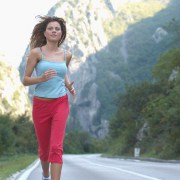 Photo: Getty Images
Photo: Getty Images
Ask some folks how they avoid running injuries, and their responses are pretty universal: “I just don’t run.” That may work for some individuals, but for people like myself who subscribe to running as if it was a personal religion, that’s definitely not the answer. I run every day, no matter how I feel, no matter what the weather, no matter where I am. Like brushing my teeth, it is a vital part of my day and I feel incomplete if I cannot head out and get a few more miles under my belt each day.
Fortunately, in my 35 years of running, an endeavor--some might now argue “addiction”--I took up at age 12, the only setback I have ever sustained from running has been one of general fatigue. Not one to ever take a day off, there are times when I feel as if I am running through the mud. My legs feel heavy and even the simplest of inclines suddenly becomes my own personal Mount Everest for the day. Still, I trudge along. Why? Because I love it, and because I love it so much, I want to ensure I remain injury-free for the long-haul.
Here are a few tips to avoid running injuries taken from the celebrated book, “Natural Running,” by Danny Abshire:
1) Understand your foot type and forefoot biomechanics. If you know you have an imbalance in your forefoot or that your feet are weak, opt for a shoe that provides flexible foot support. If you want to strengthen your feet, go barefoot or wear sandals frequently. Do this slowly at first, making the transition gradually. The goal here is to strengthen and balance your feet.
2) Understand and practice natural running form. In other words, when you run, make sure your feet contact the ground directly beneath your center of mass. Otherwise, you are simply running less efficiently and exerting undue extra energy.
3) Stay limber and maintain the range of motion to your muscles. This does not mean you have to be a human pretzel, able to tie your legs in a knot back behind your neck, but do stay flexible. Do not ignore overly tight muscles, as they can put appreciable stress on connective tissue, which can lead to problems. If your calf muscle is so tight that you cannot flex your ankle upward to land parallel to the ground, you will either land too far up on your toes, making yourself push off hard, or you will use the opposite side of the leg muscles to lift the toes and force the ankle to dorsiflex, which will then cause shin splints. Ouch!
4) Don’t compensate for injuries, pain, or biomechanics. While there may be something to the “no pain, no gain" philosophy, if you are finishing a race or reaching a goal at the expense of extreme physical pain, it’s simply not worth it. Do not subjugate health and safety simply to finish a goal. Listen to your body. “Mind over matter” may have its place, but not all of the time.
5) Don’t be so impatient. I have seen many beginning runners just take off and rum as fast and as far as they can. That is a recipe for disaster. You have to ease into it, learn about proper form, footwear, and body mechanics. Don’t be in such a hurry, as you will only set yourself up for injury and possibly end up on the couch longer than you desire. Don’t take two steps forward only to take six steps back. Patience is key!
6) At some point, most any runner will suffer an injury. It’s practically unavoidable. The secret is to minimize the injury and lessen its severity.
Other great ideas to avoid running injuries include maintaining good posture at all times, getting regular massages which actually increase energy flow, and keep an eye on those toenails. Those are easily infected if not properly taken care of, and no one likes to run with a toenail or two missing! To prevent problems in this regard, make sure your toenails do not rub the front of your shoes.
I would like to write more, but I’ve got to run--literally!
Sources:
http://www.runnersworld.com/cda/dailytips/injprev/1,7139,s6-241-288-0-0,00.html.
Abshire, Danny. Natural Running: The Simple Path to Stronger, Healthier Running . unknown: Velo Press, 2010. Print.
Reviewed May 26, 2011
Edited by Alison Stanton






Add a CommentComments
There are no comments yet. Be the first one and get the conversation started!